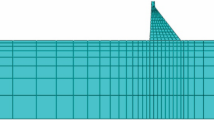Abstract
The integrity and safety of concrete dams are seriously affected by the existing cracks in dam bodies, and some serious cracks may cause dam failure or disaster. The propagation of cracks in concrete dams is accompanied by changes in energy distribution, which can be represented by changes in the structure’s system entropy. Therefore, the entropy theory can be used in analyzing the behavior of dam cracks. Due to the randomness and locality of crack propagation, it is difficult to predict the location of cracks by traditional monitoring methods. To solve this problem, the influence of spatial positions of monitoring points on inspection zones is represented by a weight index, and the weight index is determined by the distance measure method proposed in this paper. Through the weighted linear fusion method, the entropy of multiple monitoring points is obtained for analyzing the behavior of dam cracks in the selected zones. Meanwhile, the catastrophe theory is used as the variation criterion of an entropy sequence in order to predict the instability time of dam cracks. Case studies are put forward on a high arch dam, and the fusion entropy is calculated according to the monitoring data from strain gauges. Results show that the proposed method can effectively predict the occurrence time and location of dam cracks regardless of the layout of monitoring instruments, and it is a new way to analyze the occurrence and propagation of dam cracks.
Similar content being viewed by others
References
Wu Z R, Li J, Gu C S, et al. Review on hidden trouble detection and health diagnosis of hydraulic concrete structures. Sci China Tech Sci, 2007, 50: 34–50
Li Z, Chen F, Zheng J B, et al. Study on Key Problem of Super High Arch Dam. Beijing: China Electric Power Press, 2004
Zhang C H. Discrete-contact-fracture analysis of rock and concrete. Chin J Rock Mech Eng, 2008, 27: 217–235
Xu S L. The Fracture Mechanics of Concrete. Beijing: Science Press, 2011
Liu Y R, Chang Q, Yang Q, et al. Fracture analysis of rock mass based on 3-D nonlinear finite element method. Sci China Tech Sci, 2011, 54: 556–564
Pan Y, Liu Y, Cui Z, et al. Fracture analysis of brittle materials based on nonlinear FEM and application in arch dam with fractures. J Appl Math, 2013, 2013
Bao T F, Yu H. Detection of subcritical crack propagation for concrete dams. Sci China Tech Sci, 2009, 52: 3654–3660
Bao T F, Qin D, Zhou X W, et al. Abnormality monitoring model of cracks in concrete dams. Sci China Tech Sci, 2011, 54: 1914–1922
Gu C S, Li Z C, Xu B. Abnormality diagnosis of cracks in the concrete dam based on dynamical structure mutation. Sci China Tech Sci, 2011, 54: 1930–1939
Li Z C, Gu C S, Wu Z R. Abnormality diagnosis of cracks in the concrete based on double crack tip opening displacement criterion. Sci China Tech Sci, 2013, 56: 1915–1928
Li Z C, Gu C S, Wang Z Z, et al. On-line diagnosis method of crack behavior abnormality in concrete dams based on fluctuation of sequential parameter estimates. Sci China Tech Sci, 2015, 58: 415–424
Bazant Z P, Kazemi M T. Determination of fracture energy, process zone length and brittleness number from size effect, with application to rock and concrete. Int J Fract, 1990, 44: 111–131
Navalurkar R K, Hsu C T T, Kim S K, et al. True fracture energy of concrete. ACI Mater J, 1999, 96: 213–225
Atkins A G, Chen Z, Cotterell B. Prediction of the energy dissipation rate in ductile crack propagation. Fatigue Fract Eng Mater Struct, 2003, 26: 67–77
Kowsika M V, Mantena P R, Balasubramaniam K. Energy absorption and dissipation characteristics of pultruded glass-graphite/epoxy hybrid composite beams. J Thermoplast Compos Mater, 2002, 15: 227–252
Gu C S, Wu Z R. Safety Monitoring of Dams and Foundations—Theories & Methods and Their Application. Nanjing: Hohai University Press, 2006
Xu Z L. Elasticity. Beijing: Higher Education Press, 2006
Bao T F, Peng Y, Cong P J, et al. Analysis of crack propagation in concrete structures with structural information entropy. Sci China Tech Sci, 2010, 53: 1943–1948
Carpinteri A. Cusp catastrophe interpretation of fracture instability. J Mech Phys Solids, 1989, 37: 567–582
Xu C H, Ren Q W. Criterion of entropy catastrophe of stability of surrounding rock. Rock Soil Mech, 2004, 25: 437–440
Fu C H, Chen S H. Study on instability criteria of surrounding rock of underground engineering cavern based on catastrophe theory. Rock Soil Mech, 2008, 29: 167–172
Author information
Authors and Affiliations
Corresponding author
Rights and permissions
About this article
Cite this article
Wu, B., Wu, Z., Chen, B. et al. Crack status analysis for concrete dams based on measured entropy. Sci. China Technol. Sci. 59, 777–782 (2016). https://doi.org/10.1007/s11431-016-6018-1
Received:
Accepted:
Published:
Issue Date:
DOI: https://doi.org/10.1007/s11431-016-6018-1



